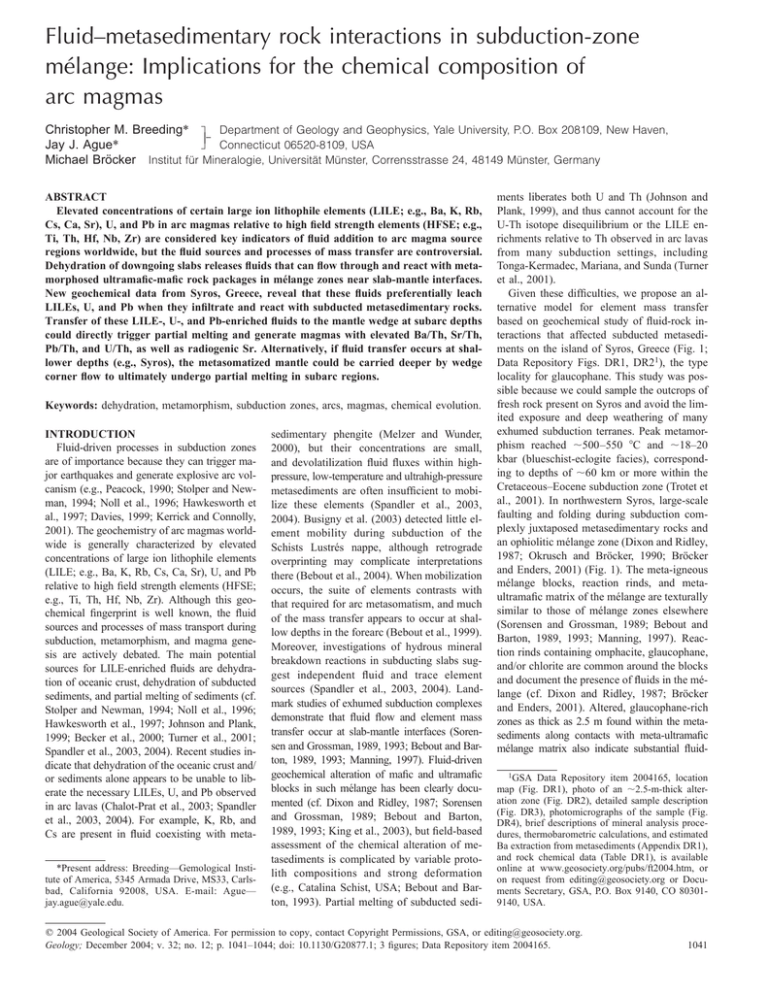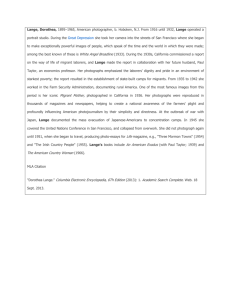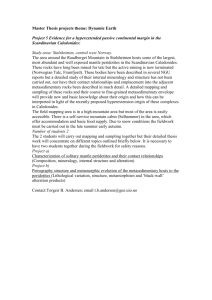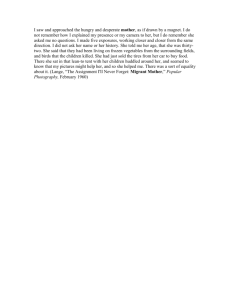Fluid–metasedimentary rock interactions in subduction-zone
advertisement

Fluid–metasedimentary rock interactions in subduction-zone mélange: Implications for the chemical composition of arc magmas Christopher M. Breeding* Department of Geology and Geophysics, Yale University, P.O. Box 208109, New Haven, Connecticut 06520-8109, USA Jay J. Ague* Michael Bröcker Institut für Mineralogie, Universität Münster, Corrensstrasse 24, 48149 Münster, Germany ABSTRACT Elevated concentrations of certain large ion lithophile elements (LILE; e.g., Ba, K, Rb, Cs, Ca, Sr), U, and Pb in arc magmas relative to high field strength elements (HFSE; e.g., Ti, Th, Hf, Nb, Zr) are considered key indicators of fluid addition to arc magma source regions worldwide, but the fluid sources and processes of mass transfer are controversial. Dehydration of downgoing slabs releases fluids that can flow through and react with metamorphosed ultramafic-mafic rock packages in mélange zones near slab-mantle interfaces. New geochemical data from Syros, Greece, reveal that these fluids preferentially leach LILEs, U, and Pb when they infiltrate and react with subducted metasedimentary rocks. Transfer of these LILE-, U-, and Pb-enriched fluids to the mantle wedge at subarc depths could directly trigger partial melting and generate magmas with elevated Ba/Th, Sr/Th, Pb/Th, and U/Th, as well as radiogenic Sr. Alternatively, if fluid transfer occurs at shallower depths (e.g., Syros), the metasomatized mantle could be carried deeper by wedge corner flow to ultimately undergo partial melting in subarc regions. Keywords: dehydration, metamorphism, subduction zones, arcs, magmas, chemical evolution. INTRODUCTION Fluid-driven processes in subduction zones are of importance because they can trigger major earthquakes and generate explosive arc volcanism (e.g., Peacock, 1990; Stolper and Newman, 1994; Noll et al., 1996; Hawkesworth et al., 1997; Davies, 1999; Kerrick and Connolly, 2001). The geochemistry of arc magmas worldwide is generally characterized by elevated concentrations of large ion lithophile elements (LILE; e.g., Ba, K, Rb, Cs, Ca, Sr), U, and Pb relative to high field strength elements (HFSE; e.g., Ti, Th, Hf, Nb, Zr). Although this geochemical fingerprint is well known, the fluid sources and processes of mass transport during subduction, metamorphism, and magma genesis are actively debated. The main potential sources for LILE-enriched fluids are dehydration of oceanic crust, dehydration of subducted sediments, and partial melting of sediments (cf. Stolper and Newman, 1994; Noll et al., 1996; Hawkesworth et al., 1997; Johnson and Plank, 1999; Becker et al., 2000; Turner et al., 2001; Spandler et al., 2003, 2004). Recent studies indicate that dehydration of the oceanic crust and/ or sediments alone appears to be unable to liberate the necessary LILEs, U, and Pb observed in arc lavas (Chalot-Prat et al., 2003; Spandler et al., 2003, 2004). For example, K, Rb, and Cs are present in fluid coexisting with meta*Present address: Breeding—Gemological Institute of America, 5345 Armada Drive, MS33, Carlsbad, California 92008, USA. E-mail: Ague— jay.ague@yale.edu. sedimentary phengite (Melzer and Wunder, 2000), but their concentrations are small, and devolatilization fluid fluxes within highpressure, low-temperature and ultrahigh-pressure metasediments are often insufficient to mobilize these elements (Spandler et al., 2003, 2004). Busigny et al. (2003) detected little element mobility during subduction of the Schists Lustrés nappe, although retrograde overprinting may complicate interpretations there (Bebout et al., 2004). When mobilization occurs, the suite of elements contrasts with that required for arc metasomatism, and much of the mass transfer appears to occur at shallow depths in the forearc (Bebout et al., 1999). Moreover, investigations of hydrous mineral breakdown reactions in subducting slabs suggest independent fluid and trace element sources (Spandler et al., 2003, 2004). Landmark studies of exhumed subduction complexes demonstrate that fluid flow and element mass transfer occur at slab-mantle interfaces (Sorensen and Grossman, 1989, 1993; Bebout and Barton, 1989, 1993; Manning, 1997). Fluid-driven geochemical alteration of mafic and ultramafic blocks in such mélange has been clearly documented (cf. Dixon and Ridley, 1987; Sorensen and Grossman, 1989; Bebout and Barton, 1989, 1993; King et al., 2003), but field-based assessment of the chemical alteration of metasediments is complicated by variable protolith compositions and strong deformation (e.g., Catalina Schist, USA; Bebout and Barton, 1993). Partial melting of subducted sedi- ments liberates both U and Th (Johnson and Plank, 1999), and thus cannot account for the U-Th isotope disequilibrium or the LILE enrichments relative to Th observed in arc lavas from many subduction settings, including Tonga-Kermadec, Mariana, and Sunda (Turner et al., 2001). Given these difficulties, we propose an alternative model for element mass transfer based on geochemical study of fluid-rock interactions that affected subducted metasediments on the island of Syros, Greece (Fig. 1; Data Repository Figs. DR1, DR21), the type locality for glaucophane. This study was possible because we could sample the outcrops of fresh rock present on Syros and avoid the limited exposure and deep weathering of many exhumed subduction terranes. Peak metamorphism reached ;500–550 8C and ;18–20 kbar (blueschist-eclogite facies), corresponding to depths of ;60 km or more within the Cretaceous–Eocene subduction zone (Trotet et al., 2001). In northwestern Syros, large-scale faulting and folding during subduction complexly juxtaposed metasedimentary rocks and an ophiolitic mélange zone (Dixon and Ridley, 1987; Okrusch and Bröcker, 1990; Bröcker and Enders, 2001) (Fig. 1). The meta-igneous mélange blocks, reaction rinds, and metaultramafic matrix of the mélange are texturally similar to those of mélange zones elsewhere (Sorensen and Grossman, 1989; Bebout and Barton, 1989, 1993; Manning, 1997). Reaction rinds containing omphacite, glaucophane, and/or chlorite are common around the blocks and document the presence of fluids in the mélange (cf. Dixon and Ridley, 1987; Bröcker and Enders, 2001). Altered, glaucophane-rich zones as thick as 2.5 m found within the metasediments along contacts with meta-ultramafic mélange matrix also indicate substantial fluid1GSA Data Repository item 2004165, location map (Fig. DR1), photo of an ;2.5-m-thick alteration zone (Fig. DR2), detailed sample description (Fig. DR3), photomicrographs of the sample (Fig. DR4), brief descriptions of mineral analysis procedures, thermobarometric calculations, and estimated Ba extraction from metasediments (Appendix DR1), and rock chemical data (Table DR1), is available online at www.geosociety.org/pubs/ft2004.htm, or on request from editing@geosociety.org or Documents Secretary, GSA, P.O. Box 9140, CO 803019140, USA. q 2004 Geological Society of America. For permission to copy, contact Copyright Permissions, GSA, or editing@geosociety.org. Geology; December 2004; v. 32; no. 12; p. 1041–1044; doi: 10.1130/G20877.1; 3 figures; Data Repository item 2004165. 1041 Figure 1. Sample locality at edge of mélange zone in northern Syros, Greece. Ophiolitic mélange consists mostly of metaigneous blocks with reaction rinds in matrix dominated by metaultramafic rock. Metasedimentary sample collected from Kampos Schists at contact with mélange matrix preserves primary interlayering of metapsammite (nonpatterned layers) and metapelite (dotted layers, except metapelite layer sampled for geochemical analysis shown in black). Matrix crosscuts layers at one end. Metasomatic alteration of layers (light gray band) is visible near contact with meta-ultramafic mélange matrix. rock interaction (Fig. DR2; see footnote 1); contacts extend regionally for linear distances of more than 2 km. The contact zones likely measured tens or even hundreds of square kilometers within the subduction zone, such that fluid-driven alteration would have affected large volumes of metasedimentary rock. CHEMICAL ALTERATION OF METASEDIMENTARY ROCK Sample Description Chemical heterogeneities inherent in layered clastic sediments often hinder geochemical in42terpretation (Bebout and Barton, 1993; Ague, 1997), so we performed high spatial resolution sampling along a single, continuous, metapelitic layer that is in contact with metaultramafic mélange matrix at one end (Figs. 1 and DR3 [see footnote 1]). The sample is representative of the centimeter- to several-meterthick alteration zones found at matrix contacts (Fig. DR2; see footnote 1) and offers an exceptionally clear view of a layer that is cut at a high angle by the matrix. Mineralogical alteration increases toward the matrix contact (Figs. DR3, DR4; see footnote 1). Relatively unaltered metapelite distal to the contact contains phengite 1 sodic-pyroxene 1 epidote 1 garnet 1 glaucophane 1 quartz 1 titanite 1 zircon 1 rutile. As the contact is approached, glaucophane increases noticeably in size and abundance; chlorite, albite, magnetite, and apatite appear; and phengite, epidote, sodic-pyroxene, quartz, and garnet abundances decrease dramatically. The meta-ultramafic mélange matrix consists mostly of chlorite, talc, serpentine, and magnetite. Thermobarometry (Holland and Powell, 1998) using the alteration assemblage yields pressures of 11.7–12.3 kbar for temperatures of 500–550 8C, corresponding to depths of at least ;40 km (Appendix DR1; see footnote 1). Albite forms pseudomorphs after jadeite-rich pyroxene, so ;12 kbar is probably a minimum recorded during exhumation and retrogression; we consider 18–20 kbar a more likely peak pressure for blueschist-eclogite facies alteration (cf. Trotet et al., 2001). 1042 Results The altered parts of the layer adjacent to the matrix contact were geochemically compared to relatively unaltered regions away from the contact (cf. Ague and van Haren, 1996; Appendix DR1; Table DR1 [see footnote 1]). Near the contact, K, Rb, Ba, Cs, Ca, Sr, U, and Pb concentrations decrease substantially within the metasedimentary layer, whereas Mg, P, and Cu increase (Fig. 2A). Ratios among Ti, Zr, Hf, Nb, Th, and rare earth element (REE) concentrations do not vary significantly across the layer, suggesting limited mobility for these elements. Correspondingly, bulk K/Th, Rb/Th, Ba/Th, Cs/Th, Ca/Th, Sr/ Th, U/Th, and Pb/Th sharply decrease, whereas Mg/Th, P/Th, and Cu/Zr increase with proximity to the meta-ultramafic matrix contact (Figs. 2B–2F). Zr/Th, Ti/Th, and Hf/Zr remain nearly constant across the metasedimentary layer and alteration zone, but are significantly different within the mélange matrix, demonstrating that mechanical mixing of matrix and metasediments did not cause the chemical changes within the altered parts of the layer (Fig. 2C). Meta-ultramafic matrix immediately adjacent to the metasedimentary layer contains low concentrations of LILEs, U, and Pb, indicating that these elements were not exchanged locally, but instead were removed by fluids flowing through the mélange (Figs. 2B–2E). K, Rb, Ba, and Cs losses result from the destruction of phengite during alteration. Epidote, garnet, and clinopyroxene breakdown released Ca. Mg addition correlates with increased glaucophane abundance and the appearance of chlorite. Apatite hosts the added P, and Cu was sequestered into chlorite (up to ;1700 ppm Cu; Appendix DR1; see footnote 1). Epidote (containing up to ;1500 ppm Pb and 2600 ppm Sr; Appendix DR1; see footnote 1) broke down, releasing Pb and Sr. Epidote was a likely host for U (cf. Zack et al., 2002), but the small U content of the rocks (1–2 ppm) prevented identification of the mineral that reacted to release U. DISCUSSION AND CONCLUSIONS The LILEs (K, Ba, Rb, Cs, Ca, Sr), U, and Pb extracted from the metasedimentary layer by mélange fluids are also elements that are commonly enriched in arc lavas, whereas HFSE elements like Hf, Th, Nb, Ti, Zr, and REEs that are commonly depleted in arcs were not strongly mobilized by the fluids (Fig. 2A). The metasomatism we envision begins with fluid generation by dehydration of metamafic (and possibly meta-ultramafic) rocks in downgoing slabs (Fig. 3). If our study area is analogous to other high-pressure mélange zones, then, at some time, the Syros mélange resided at or near the slab-mantle interface and interacted with such fluids (cf. Dixon and Ridley, 1987; Sorensen and Grossman, 1989, 1993; Bebout and Barton, 1989, 1993, 2002). Next, in a key step of the process, fluid equilibrated with metamorphosed ultramaficmafic rock packages in mélange infiltrates and reacts with metasedimentary rocks (Fig. 3). On Syros, these fluids stripped out LILEs, U, and Pb (and added Mg, Cu, and P). For example, infiltration of a K-poor mélange fluid into phengite-bearing, K-rich metapelites will drive chemical reactions that reduce chemical potential gradients for fluid species by destroying phengite and releasing K (and Rb, Ba, and Cs) to fluids. It is possible that fluids bearing some of this geochemical signature may be produced if metasedimentary rocks are infiltrated by fluids equilibrated solely with mafic crust (cf. Breeding and Ague, 2002), or if mafic crust is infiltrated by fluids equilibrated with meta-ultramafic rocks. However, reaction of metasedimentary rocks with strongly LILE-, U-, and Pb-depleted fluids from meta-ultramafic–bearing rock packages would almost certainly result in the most efficient element extraction. As an illustration, the losses of the key tracer Ba documented herein indicate that alteration of only ;7 vol% of a 1 km3 section of metasediments is sufficient to raise Ba concentrations by 100 ppm for an eruption the size of the 1980 event at Mount St. Helens, USA (Appendix DR1; see footnote 1). There is evidence for fractionation of Cs in fluids relative to Rb and K (Hart and Reid, 1991) for some arcs (e.g., Marianas) but not all (e.g., Kuriles; cf. Bebout et al., 1999); mélange-sediment contacts from a range of depths could be investigated to assess this process further. Once fluids obtain major and/or trace element enrichments through reaction with subducted metasedimentary rock, they can ascend via permeable conduits (e.g., fractures, lithologic contacts; cf. Davies, 1999; Bebout and Barton, 1993; Ague, 2003) and impart an LILE-, U-, and Pb-rich fingerprint to the mantle wedge (Fig. 3). Metasomatic minerals including phlogopite, amphibole, and pyroxene GEOLOGY, December 2004 (cf. Chesley et al., 2004) presumably hosted the transported elements in the metasomatized mantle inferred to have existed above the Syros subduction zone. This mantle could have produced arc magmas if wedge corner flow (cf. Thomas et al., 2002) dragged it to subarc depths. Furthermore, the process of LILE, Pb, and U release we document should be a proxy for deeper fluid infiltration that directly triggers partial melting in the subarc because the liberated elements reside mainly in phengite and epidote, phases that persist to ultrahighpressure conditions (Busigny et al., 2003). We note in this regard that the U-Th isotopic disequilibrium discovered in many arcs suggests that some magmas migrate as rapidly as 1000 m per year from their sources to the surface (Turner et al., 2001). Our findings provide a mechanism for the geochemical decoupling of Th from U and Pb necessary to produce this disequilibrium. If fluid-rock interactions between metamafic, meta-ultramafic, and metasedimentary reservoirs are limited, metasedimentary rocks may have to be subducted to deeper levels to liberate LILEs, U, Pb, and Th by partial melting (e.g., Johnson and Plank, 1999). ACKNOWLEDGMENTS We thank D.E. Wilbur and E.L. Donald for field assistance; J.O. Eckert for electron microprobe assistance; G.E. Bebout, J.A.D. Connolly, and J.M. Ferry for constructive reviews; and the Greece Institute of Geology and Mineral Exploration (IGME) for work permits. This work was supported by National Science Foundation grants EAR-9727134 and EAR-0105927 (Ague), United States Department of Energy grant DE-FG02-01ER15216 (Ague), a Geological Society of America Graduate Research grant (Breeding), and a Yale University Enders Research grant (Breeding). Figure 2. Geochemical plots for metasedimentary layer. A: Mass ratios. Elemental ratios calculated by dividing composition of most altered metasediments (at contact between meta-ultramafic matrix and metasedimentary layer) by least altered, precursor parts of layer. Note that K, Rb, Ba, Cs, Ca, Sr, U, and Pb concentrations decrease and Mg, P, and Cu increase in altered metasediments relative to least altered rock. Concentration ratios among limited mobility elements Ti, Zr, Th, Nb, Hf, and rare earth elements (REEs) remain unchanged across layer. Raw concentrations of these elements increase slightly toward contact, indicating residual enrichment due to ~36% loss of rock mass during metasomatism rather than mass transfer of these elements (Appendix DR1; see footnote 1). Elemental mass changes relative to Zr reference frame and are given as percentage for each highly mobile element. B–F: Geochemical profile plots for metasedimentary layer and matrix. Elements normalized to immobile Th reference frame (see plot in A). Filled symbols indicate metasediments; open symbols denote matrix adjacent to layer. Contact between meta-ultramafic matrix and metasedimentary layer at x 5 0. Vertical dotted line indicates extent of visible alteration near contact (Fig. 1). MgO/Th (B) increases near matrix contact and is likewise elevated in matrix, whereas Zr/Th (C) remains relatively unchanged across layer, but is distinctly higher in mélange matrix, indicating that mechanical mixing was not significant. K2O/ Th (D), Ba/Th (D), U/Th (E), Pb/Th (E), Sr/Th (F), and Cs/Th (F) decrease as contact is approached. Note that mélange matrix does not have elevated K2O/Th, Ba/Th, U/Th, Pb/Th, Sr/ Th, or Cs/Th relative to metasediments, indicating that matrix adjacent to metasediments was not local sink for material removed from layers. GEOLOGY, December 2004 REFERENCES CITED Ague, J.J., 1997, Crustal mass transfer and index mineral growth in Barrow’s garnet zone, northeast Scotland: Geology, v. 25, p. 73–76. Ague, J.J., 2003, Fluid infiltration and transport or major, minor, and trace elements during regional metamorphism of carbonate rocks, Wepawaug Schist, Connecticut, USA: American Journal of Science, v. 303, p. 753–816. Ague, J.J., and van Haren, J.L.M., 1996, Assessing metasomatic mass and volume changes using the bootstrap, with application to deep crustal hydrothermal alteration of marble: Economic Geology, v. 91, p. 1169–1182. Bebout, G.E., and Barton, M.D., 1989, Fluid flow and metasomatism in a subduction-zone hydrothermal system: Catalina Schist terrane, California: Geology, v. 17, p. 976–980. Bebout, G.E., and Barton, M.D., 1993, Metasomatism during subduction: Products and possible paths in the Catalina Schist, California: Chemical Geology, v. 108, p. 61–92. Bebout, G.E., and Barton, M.D., 2002, Tectonic and metasomatic mixing in a high-T, subductionzone mélange—Insights into the geochemical evolution of the slab-mantle interface: Chemical Geology, v. 187, p. 79–106. Bebout, G.E., Ryan, J.G., Leeman, W.P., and Bebout, A.E., 1999, Fractionation of trace elements by subduction-zone metamorphism—Effect of 1043 Figure 3. Schematic model of fluid flow in subductionzone mélange. Dehydration fluids from subducting slab become focused into mélange zone at slab-mantle interface. Fluids moving through meta-ultramafic matrix (dashed arrows) form reaction rinds (thick black lines) during interaction with meta-igneous blocks. Fluids become enriched in large ion lithophile elements (LILE; K, Ba, Rb, Cs, Ca, Sr), U, and Pb when they infiltrate and react with metasedimentary rocks. Newly enriched fluids exploit permeable conduits such as fracture networks to ascend and add LILE, U, and Pb to mantle wedge. Some fluids may continue to flow along slab to shallower levels of subduction zone. Reaction rinds on meta-igneous blocks consist mainly of K-poor minerals (omphacite, glaucophane, and/or chlorite; Dixon and Ridley, 1987) and cannot be sinks for K, Ba, Rb, and Cs liberated from metasedimentary rocks. convergent-margin thermal evolution: Earth and Planetary Science Letters, v. 171, p. 63–81. Bebout, G.E., King, R., Agard, P., Kobayashi, K., and Nakamura, E., 2004, Mineral chemical records of prograde devolatilization in Alpine HP/UHP metasediments, in Proceedings, International Symposium on Water-Rock Interaction, 11th, Saratoga Springs, Volume 1: Leiden, A.A. Balkema Publishers, p. 257–261. Becker, H., Jochum, K.P., and Carlson, R.W., 2000, Trace element fractionation during dehydration of eclogites from high-pressure terranes and the implications for element fluxes in subduction zones: Chemical Geology, v. 163, p. 65–99. Breeding, C.M., and Ague, J.J., 2002, Large-scale flow of slab-derived fluids in an accretionary prism, Otago Schist, New Zealand: Geology, v. 30, p. 499–502. Bröcker, M., and Enders, M., 2001, Unusual bulkrock compositions in eclogite-facies rocks from Syros and Tinos (Cyclades, Greece): Implications for U-Pb zircon geochronology: Chemical Geology, v. 175, p. 581–603. Busigny, V., Cartigny, P., Philippot, P., Ader, M., and Javoy, M., 2003, Massive recycling of nitrogen and other fluid-mobile elements (K, Rb, Cs, H) in a cold slab environment: Evidence from HP to UHP oceanic metasediments of the Schists Lustrés nappe (western Alps, France): Earth and Planetary Science Letters, v. 215, p. 27–42. Chalot-Prat, F., Ganne, J., and Lombard, A., 2003, No significant element transfer from the oceanic plate to the mantle wedge during subduction and exhumation of the Tethys lithosphere (Western Alps): Lithos, v. 69, p. 69–103. Chesley, J., Righter, K., and Ruiz, J., 2004, Large- 1044 scale mantle metasomatism: A Re-Os perspective: Earth and Planetary Science Letters, v. 219, p. 49–60. Davies, J.H., 1999, The role of hydraulic fractures and intermediate-depth earthquakes in generating subduction-zone magmatism: Nature, v. 398, p. 142–145. Dixon, J.E., and Ridley, J.R., 1987, Syros, in Helgeson, H.C., ed., Chemical transport in metasomatic processes: Boston, Reidel Publishing Company, p. 489–501. Hart, S.R., and Reid, M.R., 1991, Rb/Cs fractionation—A link between granulite metamorphism and the S-process: Geochimica et Cosmochimica Acta, v. 55, p. 2379–2383. Hawkesworth, C.J., Turner, S.P., McDermott, F., Peate, D.W., and van Calsteren, P., 1997, UTh isotopes in arc magmas: Implications for element transfer from the subducted crust: Science, v. 276, p. 551–555. Holland, T.J.B., and Powell, R., 1998, An internally consistent thermodynamic data set for phases of petrological interest: Journal of Metamorphic Geology, v. 16, p. 309–343. Johnson, M.C., and Plank, T., 1999, Dehydration and melting experiments constrain the fate of subducted sediments: Geochemistry, Geophysics, and Geosystems, v. 1, doi: 10.1029/ 1999GC000014. Kerrick, D.M., and Connolly, J.A.D., 2001, Metamorphic devolatilization of subducted marine sediments and the transport of volatiles into the Earth’s mantle: Nature, v. 411, p. 293–296. King, R.L., Kohn, M.J., and Eiler, J.M., 2003, Constraints on the petrologic structure of the subduction zone slab-mantle interface from Franciscan Complex exotic ultramafic blocks: Geological Society of America Bulletin, v. 115, p. 1097–1109. Manning, C.E., 1997, Coupled reaction and flow in subduction zones: Silica metasomatism in the mantle wedge, in Jamtveit, B., and Yardley, B.W.D., eds., Fluid flow and transport in rocks: London, Chapman and Hall, p. 139–148. Melzer, S., and Wunder, B., 2000, Island-arc basalt alkali ratios: Constraints from phengite-fluid partitioning experiments: Geology, v. 28, p. 583–586. Noll, P.D., Newsom, H.E., Leeman, W.P., and Ryan, J.G., 1996, The role of hydrothermal fluids in the production of subduction zone magmas: Evidence from siderophile and chalcophile trace elements and boron: Geochimica et Cosmochimica Acta, v. 60, p. 587–611. Okrusch, M., and Bröcker, M., 1990, Eclogites associated with high-grade blueschists in the Cyclades archipelago, Greece: A review: European Journal of Mineralogy, v. 2, p. 451–478. Peacock, S.M., 1990, Fluid processes in subduction zones: Science, v. 248, p. 329–337. Sorensen, S.S., and Grossman, J.N., 1989, Enrichment of trace elements in garnet amphibolites from a paleo-subduction zone: Catalina Schist, southern California: Geochimica et Cosmochimica Acta, v. 53, p. 3155–3177. Sorensen, S.S., and Grossman, J.N., 1993, Accessory minerals and subduction zone metasomatism: A geochemical comparison of two mélanges (Washington and California, U.S.A.): Chemical Geology, v. 110, p. 269–297. Spandler, C., Hermann, J., Arculus, R., and Mavrogenes, J., 2003, Redistribution of trace elements during prograde metamorphism from lawsonite blueschist to eclogite facies: Implications for deep subduction-zone processes: Contributions to Mineralogy and Petrology, v. 146, p. 205–222. Spandler, C., Hermann, J., Arculus, R., and Mavrogenes, J., 2004, Geochemical heterogeneity and element mobility in deeply subducted oceanic crust; insights from high-pressure mafic rocks from New Caledonia: Chemical Geology, v. 206, p. 21–42. Stolper, E., and Newman, S., 1994, The role of water in the petrogenesis of Mariana trough magmas: Earth and Planetary Science Letters, v. 121, p. 293–325. Thomas, R.B., Hirschmann, M.M., Cheng, H., Reagan, M.K., and Edwards, L., 2002, (231Pa/235U)(230Th/238U) of young mafic volcanic rocks from Nicaragua and Costa Rica and the influence of flux melting on U-series systematics of arc lavas: Geochimica et Cosmochimica Acta, v. 66, p. 4287–4309. Trotet, F., Vidal, O., and Jolivet, L., 2001, Exhumation of Syros and Sifnos metamorphic rocks (Cyclades, Greece). New constraints on the P-T paths: European Journal of Mineralogy, v. 13, p. 901–920. Turner, S., Evans, P., and Hawkesworth, C., 2001, Ultrafast source-to-surface movement of melt at island arcs from 226Ra-230Th systematics: Science, v. 292, p. 1363–1366. Zack, T., Foley, S.F., and Rivers, T., 2002, Equilibrium and disequilibrium trace element partitioning in hydrous eclogites (Trescolmen, Central Alps): Journal of Petrology, v. 43, p. 1947–1974. Manuscript received 9 June 2004 Revised manuscript received 16 August 2004 Manuscript accepted 31 August 2004 Printed in USA GEOLOGY, December 2004





